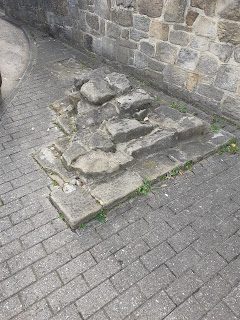With our fine weather, weekend visits to Lakeland dying a death this year, my wife and I decided to resume our North-East coastal adventures with a trip down to Teesside on Sunday. We'd been to Redcar and its sandy expanses before, but not for a good few years; so we thought we'd renew acquaintances.
To tell the truth, we didn't really call in at Redcar proper, but rather parked up at the fancily-named Majuba Car Park on the front (essentially at Coatham, I suppose) with the intention of setting off along the beach westwards towards South Gare and the mouth of the Tees. First of all, however, we had a hot chocolate at the local Recreation Centre, and Angie insisted on a visit to a local ice cream parlour a couple of hundred yards in the opposite direction for her customary 'Lemon Top'. Well, Redcar is supposed to be the home of the tasty creation.
Meanwhile, I busied myself with a look at the Redcar Beacon:
The Beacon, we are told, is Redcar's 'vertical pier', "offering visitors the chance to enjoy a 360 degree view of the seafront". The viewing platform was, however, closed due to 'antisocial behaviour', or some such reason.
Never mind, off we set to the west along a four mile stretch of really quite beautiful beach that links the town to the mouth of the Tees at South Gare - an expanse of natural beauty known, I think, as Coatham Sands. Here I regaled my wife with the well-known story of how the Dunkirk scenes from the film Atonement were set here in 2006. Suitably bored with my historical banter, she sucked noisily on her gelato concoction whilst I largely talked to myself.
The walk was a long, if pleasant, one; the natural beauty of our surroundings punctuated rudely by the whirling offshore wind turbines and, of course, the looming gaze of the half-demolished Redcar Steel Works.
As the pier at South Gare approached we looked for a way to get as close to the end of the structure as possible. The warning signs put us off, though, and we satisfied our curiosity with a little dead-end expedition along the western fence of the pier and a snoop around the nearby gun emplacements known as the Coastal Battery.
We continued southwards along the access road, inland, before turning eastwards towards the skeleton of the Steel Works. Along this narrow, dead-end road we noticed more than a dozen parked-up camper vans, many, many cars, with an almost constant stream of fresh incomers. We wondered quite what was going on in this remote corner of Teesside at such a late hour (there was only a limited amount of daylight left) and joked that it might be something of a sordid nature. Subsequent research has revealed that we weren't wrong.*
One of the final vehicles that sped past us before we veered off across the sand dunes was a police car. Mmm. Anyway, off we strode, back to the beach, and thence eastwards back to the car. And at the car park I found a fading information board, a part of which I shall reproduce below for your convenience:
Very interesting.
* use your imagination. And Google, perhaps.



























